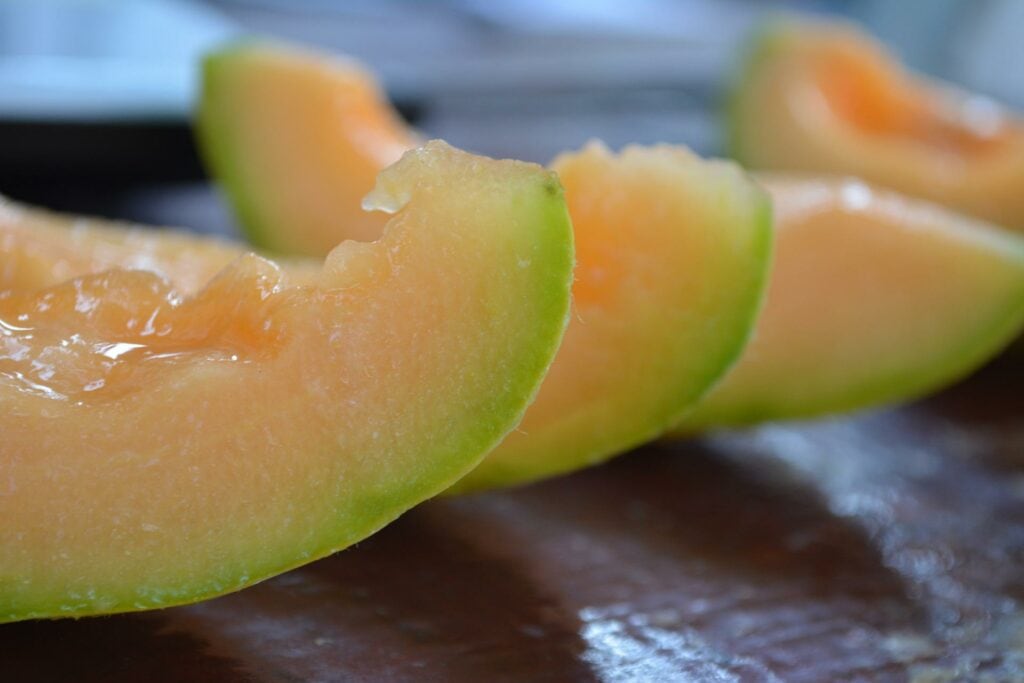Can You Grow Cantaloupe on a Trellis? Tips for Growing Vertically
-
Kristin Hitchcock
- Last updated:

Cantaloupe typically is not a plant that you grow on a trellis, as the fruits are very heavy. However, you can grow your cantaloupe vertically to save some room. These vines can be very sprawling when left on the ground, and you can save a bit of room when you grow them on a trellis.
For this reason, we highly recommend lovers of cantaloupe consider growing them on a trellis, especially if you have a small garden. Cantaloupes require about 3–4 feet between them, though some may sprawl as much as 20 feet. When you grow them on a trellis, you cut this range by over half.
Plus, when you plant cantaloupe vertically, it also makes it easier to harvest. You don’t have to do as much stretching or pulling to reach the veggies. Instead, they’re all on display on a trellis. It also keeps the fruit off the ground, which helps keep them clean and above the reach of pests. It may also help prevent diseases on the foliage since they will be raised above the ground as well.
 How to Grow Cantaloupes Vertically
How to Grow Cantaloupes Vertically
Growing a cantaloupe on a trellis is not challenging in the least. You can make the trellis out of many different materials or make one yourself. Because these vines are dense and the fruits heavy, the trellis will need to be a bit sturdier than many options out there. Livestock panels, welded wire, and hog fencing all work well. You may be unable to use traditional trellises, as they are often not made as well.
These vines do not sprawl very well. Therefore, the gaps will need to be small.
You’ll need very solid posts to hang your wire material on. U-posts or steel posts typically work well. You can use solid wooden posts as long as they are decently large. You can typically zip-tie the wire to the supports without a significant problem. The more zip-ties, the better.
Naturally, the cantaloupe should vine its way around the trellis as it grows. You may need to tie it on at first so that the vines will grow upwards in the correct direction and not just sprawl upon the ground.
When the fruits begin to grow, you’ll have to support them with a cloth sling of some sort. Otherwise, the fruits will get too heavy and fall off before they become ripe. Keep the slings tight enough but ensure that you give the fruits enough room to grow.

How to Keep Cantaloupes on the Trellis
Sometimes, cantaloupes will become “untrained.” In other words, they simply fall off the trellis and start sprawling instead. You’ll often have to provide some help as the cantaloupe grows. Luckily, simply snaking the vine around the trellis is enough. The trellis will become somewhat crowded over time, as these vines can become extremely bountiful.
Using some support for the melons is vital to keep the vines on the trellis. Otherwise, the heavy fruits may pull off the vines (or just fall off).
If you notice any runaway vines, you can move them back to the trellis and secure than with plant ties. Cantaloupe plants will sometimes try and find supports beyond the trellis.
Harvesting Cantaloupes on a Trellis
Harvesting cantaloupes on a trellis is not difficult. In fact, it is much easier than harvesting cantaloupes on the ground! You’ll be able to see the cantaloupes easier when on the trellis, and you won’t have to worry about the fruit rotting quite as fast. Pests also usually can’t reach the higher fruits.
Beyond removing the supports when harvesting, you won’t have to do anything particularly fancy when your vines are on a trellis.

Is it Better to Grow Cantaloupe on the Ground or a Trellis?
Growing cantaloupe on a trellis can be a bit more work. You’ll have to train the vines and provide support for the fruits. However, it is arguably a much better option than growing cantaloupe on the ground.
Firstly, vertical growing allows cantaloupes to avoid common ground pests. Increased airflow under and around the leaves prevents rotting and diseases. Your cantaloupe melons will not rot as quickly or easily. They also won’t be eaten nearly as easily since they are higher off the ground.
Weeding under a trellis is also extremely easy. However, when you grow cantaloupe on the ground, it can be challenging to weed underneath the vines without upsetting the plant. Keeping an eye on the fruit and vines is also easier.
When it comes to harvest time, taking the melons off the vines is much easier when they are on a trellis. You won’t have to pull and reach quite as far. Instead, all the fruits will be displayed (and you’ll already know where they all are).
Will Cantaloupe Grow Up a Fence?
With some help, you may convince your cantaloupe to grow up a fence. Cantaloupe plants need some training to grow up a fence, as they tend to sprawl instead. However, with some plant ties, you can encourage them to grow up a fence instead.
This provides many benefits, such as saving space. Cantaloupe can take up quite a bit of room when left to sprawl, but they will only take up a few feet of ground space when you put them on a fence.
You will need to support the cantaloupe when they begin to grow on a fence. The vines cannot support a full cantaloupe. If you don’t provide an extra sling or fruit net, the vines will break or the fruits will fall off.
None of these steps are particularly difficult or time-consuming, you’ll just need to be prepared with ties and fruit supports.

How Tall Do Cantaloupe Plants Grow?
You’ll need the trellis to be about 6- to 7-feet tall to support a cantaloupe plant. You can help the vines grow outwards and upwards by using plant ties, which are often necessary. These plants grow lots of big leaves, so you’ll need to be prepared with the proper amount of space. Things can get quite crowded, but that isn’t usually a significant problem.
Simply be sure that the plant is getting enough light. If all the leaves get shoved into one area, they may not absorb all of the light they need. Spread the plant outwards as well as upwards.
 Conclusion
Conclusion
We highly recommend that you grow cantaloupes on trellises. The plant will be less susceptible to diseases and out of reach of most pests. Harvesting and caring for the plant is also much easier when it grows vertically.
However, you will need to provide some extra care for the plant. Cantaloupe plants often need to be trained to climb upwards, so you’ll need to tie them to the trellis.
Fruits will also need extra support, as the vine won’t be able to hold them up. Fruits will drop to the ground before they are ripe unless you use a sling or net to provide extra support. Be sure the melon is snug enough so that it doesn’t fall out, but you should also provide them with enough room to grow.
Featured Image Credit: Pixabay
Contents
 How to Grow Cantaloupes Vertically
How to Grow Cantaloupes Vertically